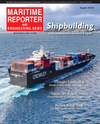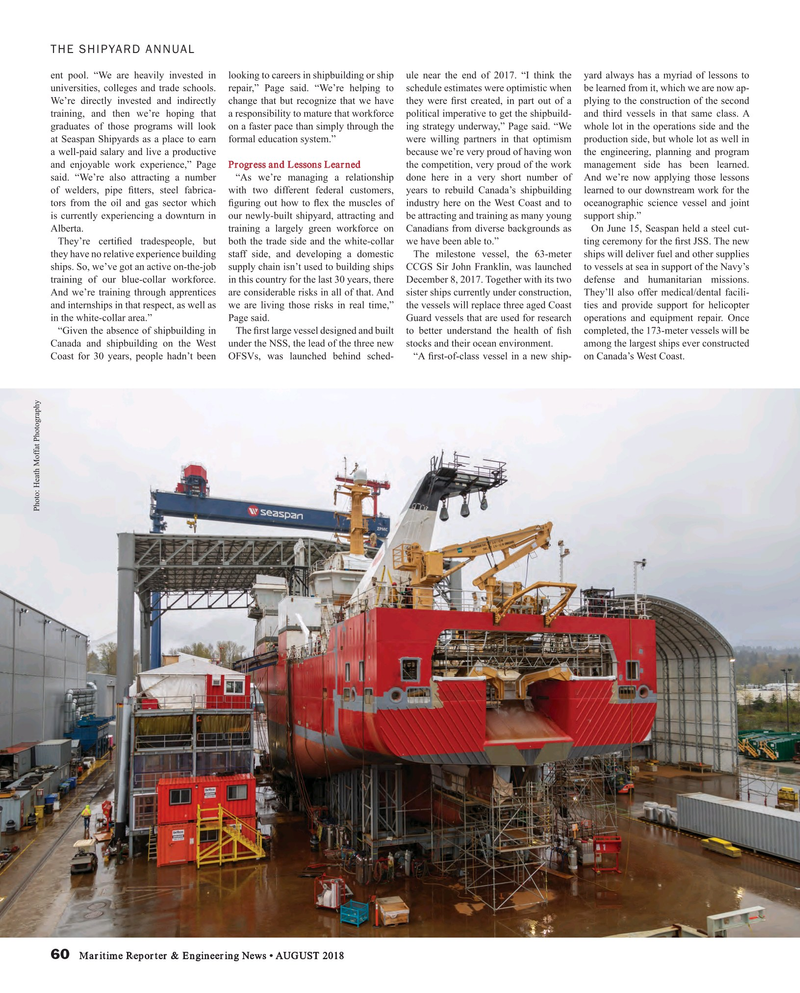
Page 60: of Maritime Reporter Magazine (August 2018)
The Shipyard Edition
Read this page in Pdf, Flash or Html5 edition of August 2018 Maritime Reporter Magazine
THE SHIPYARD ANNUAL ent pool. “We are heavily invested in looking to careers in shipbuilding or ship ule near the end of 2017. “I think the yard always has a myriad of lessons to universities, colleges and trade schools. repair,” Page said. “We’re helping to schedule estimates were optimistic when be learned from it, which we are now ap-
We’re directly invested and indirectly change that but recognize that we have they were ? rst created, in part out of a plying to the construction of the second training, and then we’re hoping that a responsibility to mature that workforce political imperative to get the shipbuild- and third vessels in that same class. A graduates of those programs will look on a faster pace than simply through the ing strategy underway,” Page said. “We whole lot in the operations side and the at Seaspan Shipyards as a place to earn formal education system.” were willing partners in that optimism production side, but whole lot as well in a well-paid salary and live a productive because we’re very proud of having won the engineering, planning and program and enjoyable work experience,” Page Progress and Lessons Learned the competition, very proud of the work management side has been learned. said. “We’re also attracting a number “As we’re managing a relationship done here in a very short number of And we’re now applying those lessons of welders, pipe ? tters, steel fabrica- with two different federal customers, years to rebuild Canada’s shipbuilding learned to our downstream work for the tors from the oil and gas sector which ? guring out how to ? ex the muscles of industry here on the West Coast and to oceanographic science vessel and joint is currently experiencing a downturn in our newly-built shipyard, attracting and be attracting and training as many young support ship.”
Alberta. training a largely green workforce on Canadians from diverse backgrounds as On June 15, Seaspan held a steel cut-
They’re certi? ed tradespeople, but both the trade side and the white-collar we have been able to.” ting ceremony for the ? rst JSS. The new they have no relative experience building staff side, and developing a domestic The milestone vessel, the 63-meter ships will deliver fuel and other supplies ships. So, we’ve got an active on-the-job supply chain isn’t used to building ships CCGS Sir John Franklin, was launched to vessels at sea in support of the Navy’s training of our blue-collar workforce. in this country for the last 30 years, there December 8, 2017. Together with its two defense and humanitarian missions.
And we’re training through apprentices are considerable risks in all of that. And sister ships currently under construction, They’ll also offer medical/dental facili- and internships in that respect, as well as we are living those risks in real time,” the vessels will replace three aged Coast ties and provide support for helicopter in the white-collar area.” Page said. Guard vessels that are used for research operations and equipment repair. Once “Given the absence of shipbuilding in The ? rst large vessel designed and built to better understand the health of ? sh completed, the 173-meter vessels will be
Canada and shipbuilding on the West under the NSS, the lead of the three new stocks and their ocean environment. among the largest ships ever constructed
Coast for 30 years, people hadn’t been OFSVs, was launched behind sched- “A ? rst-of-class vessel in a new ship- on Canada’s West Coast.
Photo: Heath Moffat Photography 60 Maritime Reporter & Engineering News • AUGUST 2018
MR #8 (58-65).indd 60 MR #8 (58-65).indd 60 8/6/2018 11:30:44 AM8/6/2018 11:30:44 AM

 59
59

 61
61
